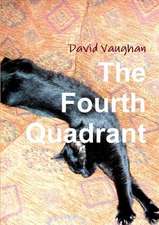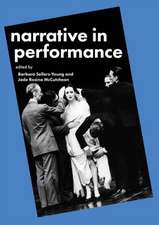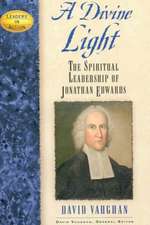Merce Cunningham: Creative Elements: Choreography and Dance Studies Series
Editat de David Vaughanen Limba Engleză Hardback – 26 aug 2016
The essays collected in this special issue of Choreography and Dance were written over the last few years and discuss various aspects of the work of Cunningham as seen both from the outside and the inside.
| Toate formatele și edițiile | Preț | Express |
|---|---|---|
| Paperback (1) | 230.18 lei 43-57 zile | |
| Taylor & Francis – iun 1996 | 230.18 lei 43-57 zile | |
| Hardback (1) | 938.16 lei 43-57 zile | |
| Taylor & Francis – 26 aug 2016 | 938.16 lei 43-57 zile |
Din seria Choreography and Dance Studies Series
-
 Preț: 311.99 lei
Preț: 311.99 lei -
 Preț: 408.16 lei
Preț: 408.16 lei - 22%
 Preț: 237.44 lei
Preț: 237.44 lei - 26%
 Preț: 238.67 lei
Preț: 238.67 lei - 25%
 Preț: 770.62 lei
Preț: 770.62 lei - 26%
 Preț: 230.18 lei
Preț: 230.18 lei -
 Preț: 438.56 lei
Preț: 438.56 lei -
 Preț: 260.65 lei
Preț: 260.65 lei - 18%
 Preț: 1004.34 lei
Preț: 1004.34 lei -
 Preț: 397.88 lei
Preț: 397.88 lei -
 Preț: 478.26 lei
Preț: 478.26 lei -
 Preț: 383.63 lei
Preț: 383.63 lei -
 Preț: 350.96 lei
Preț: 350.96 lei - 18%
 Preț: 1008.86 lei
Preț: 1008.86 lei -
 Preț: 503.25 lei
Preț: 503.25 lei -
 Preț: 355.20 lei
Preț: 355.20 lei - 15%
 Preț: 567.48 lei
Preț: 567.48 lei - 15%
 Preț: 588.27 lei
Preț: 588.27 lei - 15%
 Preț: 564.12 lei
Preț: 564.12 lei
Preț: 938.16 lei
Preț vechi: 1413.02 lei
-34% Nou
Puncte Express: 1407
Preț estimativ în valută:
179.55€ • 186.95$ • 151.74£
179.55€ • 186.95$ • 151.74£
Carte tipărită la comandă
Livrare economică 10-24 martie
Preluare comenzi: 021 569.72.76
Specificații
ISBN-13: 9781138149274
ISBN-10: 1138149276
Pagini: 118
Dimensiuni: 170 x 248 mm
Greutate: 0.84 kg
Ediția:1
Editura: Taylor & Francis
Colecția Routledge
Seria Choreography and Dance Studies Series
Locul publicării:Oxford, United Kingdom
ISBN-10: 1138149276
Pagini: 118
Dimensiuni: 170 x 248 mm
Greutate: 0.84 kg
Ediția:1
Editura: Taylor & Francis
Colecția Routledge
Seria Choreography and Dance Studies Series
Locul publicării:Oxford, United Kingdom
Cuprins
Chapter 1 Introduction; Chapter 2 Cunningham's Recent Work: Does It Tell a Story?, JoanAcocella; Chapter 3 Merce Cunningham and Meaning: The Zen Connection, Marilyn VaughanDrown; Chapter 4 Visual Artists Design for the Merce Cunningham Dance Company, 1967–1970, NelsonRivera; Chapter 5 The Roles of David Tudor in the Early Repertory of the Merce Cunningham Dance Company, JohnHolzaepfel; Chapter 6 Electronic Music for the Merce Cunningham Dance Company, GordonMumma; Chapter 7 Merce Cunningham and John Cage: Choreographic Cross-currents, WilliamFetterman; Chapter 8 Merce Cunningham: Making Dances with the Computer, TheclaSchiphorst; Chapter 9 Dance on Film: Notes on the making of CRWDSPCR, ElliotCaplan; contri Notes on Contributors; Index;
Notă biografică
Joan Acocella writes about dance and other arts for The New Yorker, The New York Review of Books, and other magazines. She is the author of Mark Morris (1993)., Elliot Caplan is filmmaker-in-residence at the Cunningham Dance Foundation. He collaborated with Merce Cunningham on Deli Commedia, Points in Space, Changing Steps, and Beach Birds For Camera. His documentary portrait, Cage/Cunningham, was awarded the prize for Best Documentary at the 1992 IMZ Dance Screen Festival in Frankfurt. Beach Birds For Camera won the Grand Prize at the 1993 IMZ Festival, as well as the Grand Prize at the New York Dance On Camera Festival, 1993, and the Grand Prix International Video Dance, Stockholm, 1994., Marilyn Vaughan Drown has a Master of Arts Degree in Dance History from the University of California. She teaches dance at Crafton Hills College and practices Zen at the Zen Center in Los Angeles. She has published a report in Dance Research Journal and is currently working on a screenplay., William Fetterman was educated at Muhlenberg College and at New York University, where he received his Ph.D. in 1992. He has published several articles on theatre, composed performance poetry, and is the author of John Cage's Theatre Pieces: Notations and Performances (Harwood Academic Publishers)., John Holzaepfel is a pianist, pedagogue, and musicologist. He studied piano with Ellsworth Snyder, who nurtured both his interest in contemporary music and his devotion to the piano-playing of earlier times. He also studied with Todd Welbourne at the University of Wisconsin, where he took his undergraduate degree in piano. He has given recitals of music from the 18th to the 20th centuries, and has published articles on medieval and contemporary music. He received his Ph.D. in historical musicology from the City University of New York, where he wrote his dissertation on David Tudor and the Performance of American Experimental Music, 1950–1959., Gordon Mumma was a composer and per




























